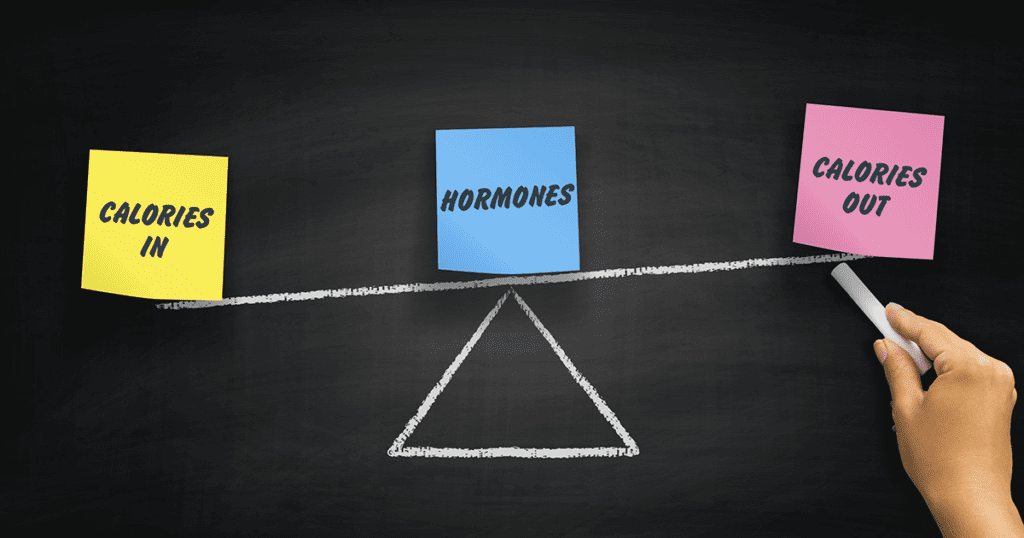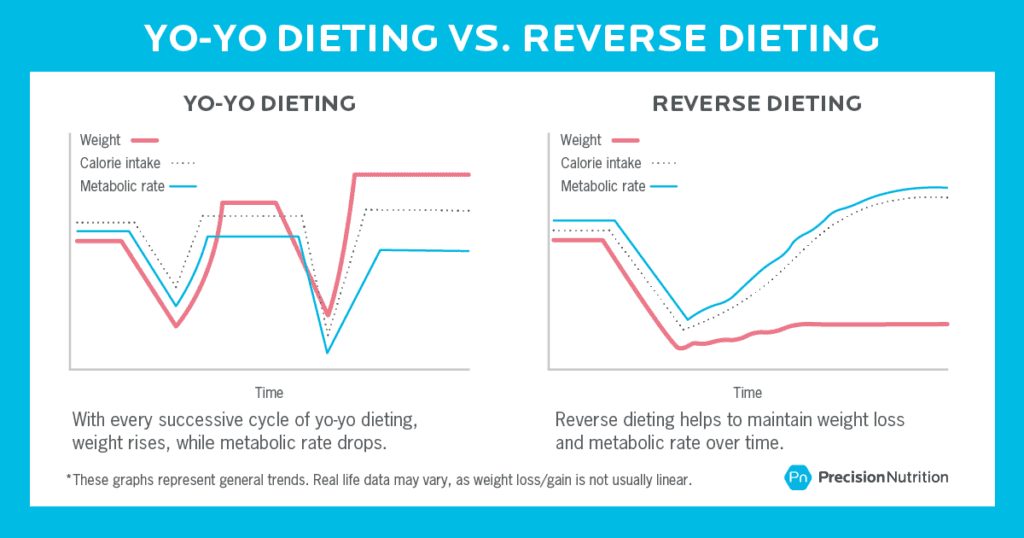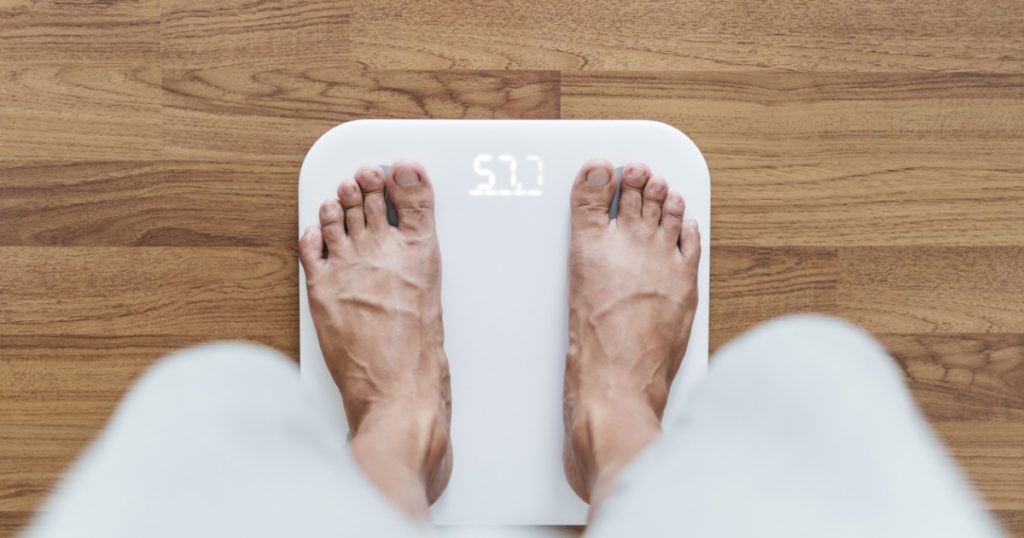Reviewed by Brian St. Pierre, MSc, RD, CSCS
If Jerry Seinfeld were into health and fitness he’d ask, “What’s the deal with the 1200-Calorie diet?”
(Thanks for the joke, Dad.)
But seriously: If you look at the caloric recommendations of many popular weight loss diets, you’ll notice that 1200 Calories is often the “ideal target” for women. (For men, it’s often 1500.)
The 1200-Calorie diet is also an extremely popular topic on Reddit, TikTok, and Instagram. Allegedly, even Kim Kardashian followed this prescriptive diet.
There’s nothing special about 1200 Calories specifically.
However, all this hype makes a person—or a concerned coach—wonder about low-calorie diets in general.
Most importantly: Is such a low caloric target safe and sustainable?
In the following article, we’ll address that question, as well as:
- Why some people don’t lose weight on 1200–Calorie diets. (Hint: It has nothing to do with their thyroid or metabolic adaptation.)
- The daily calorie target that tends to stimulate weight loss—and not unbearable cravings or deprivation.
- Four science-supported strategies that help regulate appetite and hunger—so folks can follow their food plan for the long term.
But first…
Where did the 1200-Calorie diet come from, anyway??
It’s thought that the 1200-Calorie Diet dates back to 1918, when Lulu Hunt Peters, MD, released a book titled Diet and Health with Key to the Calories.
Dr. Peters writes in an entertaining manner, which may be what led to the book’s lasting popularity. In 2005, the book was reprinted digitally, more than 80 years after its initial release and long after Dr. Peters’ death.
For example, within its pages, you’ll find lots of messy stick and circle figures, along with advice to “skip this chapter. It will not interest you in the least.”
Among the book’s prescriptive advice, readers are cautioned against consuming too much animal protein, as it “makes the disposition more vicious.” For exercise, Dr. Peters encourages women to brush their hair vigorously, “at least 200 double strokes all over the head.”
(Not everything from this book survived the test of time.)
Embedded throughout is encouragement to consume 1200 Calories. (Says the book: “You will be surprised how much 1200 Calories will be if the food is judiciously selected.”)
Dr. Peters’ thinking—as well as the thinking of today’s 1200-Calorie diet proponents—goes like this:
- Most women need about 2200 daily Calories to maintain their weight.
- A pound of fat contains 3500 Calories.
- If you consume 1000 fewer daily Calories than you need, you will lose about two pounds of fat a week. (Because math.)
Thing is, while the arithmetic is straightforward, fat loss is anything but.
Because—quick fact check—not all women’s total daily energy expenditure (TDEE) will be 2200 Calories. A woman’s calorie needs will depend on many factors, including her body size, lean mass, age, dieting history, and activity levels.1
TDEE might be much higher than 2200 for some women and much lower for others.
In other words, 2200 Calories is an average—and not a universal number that applies to all women.
Why some people don’t lose weight on a 1200-Calorie diet
Very low calorie diets can and do lead to fat loss—if you stick to them, consistently.
For many women, 1200 represents about half the calories they need to maintain their weight. That’s enough of a deficit to lead to weight loss for most people, including folks with thyroid problems.
It can even overcome adaptive thermogenesis—or the “slowing” of the metabolism after an extended period of caloric deficit. (Colloquially, this is what some folks call “the starvation response.”)
We know about this because of research done almost 80 years ago.
How your body fights back against the 1200-Calorie diet
In the mid-1940s, University of Minnesota researchers published a study called “The Minnesota Starvation Experiment.”
In this study, 36 men voluntarily semi-starved themselves for six months—all in the name of science. The men ate 1570 daily Calories from food carefully portioned by dietitians. The meals added up to half their normal intake.
Interestingly, their basal metabolic rates did drop—by a whopping 40 percent—but it didn’t stop them from losing weight. After six months, every single one of the men had lost about 25 percent of their weight—no exceptions. 2, 3
Problem is, semi-starvation is brutal.
The longer you sustain such a severe calorie deficit, the more your biology fights you, turning down metabolism and turning up hunger and cravings.
(Your body wants you to survive the famine!)
As a result, you may find—as the men in the Minnesota starvation study did—food becomes all you talk about, think about, and dream about.
Food preoccupation became so intense for the Minnesota men that they would routinely lick their plates clean after meals, and even rummage through the trash for food scraps between meals.
(Many of these behaviors persisted even after the study ceased. Study alumni reported needing to keep snacks with them at all times, so they would never have to worry about hunger again.)
During sustained caloric deprivation, many other biological chemicals get out of whack, too, leading to more headaches, depression, anxiety, and cold intolerance.
Plus, your ability to concentrate drops, mostly because you can’t focus on anything other than “WHEN’S MY NEXT MEAL???”
At this low calorie amount, it’s also difficult to consume enough food to meet all your nutrient needs, too. So, the risk of malnutrition goes up.
How the 1200-Calorie diet often fails
Because of everything we mentioned above, it’s difficult to consume 1200 Calories day after day.
Instead, what usually happens: Folks nail their calorie targets some days, and wildly exceed it on others.
“Clients say ‘I’m eating 1200 or 1300 Calories a day.’ That’s usually true-ish,” says Brian St. Pierre, MS, RD, Precision Nutrition’s Director of Nutrition. “They’re in the ballpark four to five days a week.”
On the other days, however, dieters find themselves drawn to highly indulgent, calorie-dense foods like…
- A whole pizza, plus two beers (2200+ Calories)
- A burrito, two margaritas, chips, and guacamole (2000+ Calories)
- A gourmet burger with fries and a cola (1500 Calories)
- Pasta with chicken and roasted garlic from The Cheesecake Factory (1910 Calories)
Even if you’re following your regular low-cal diet for most of the day, just one of the above meals can push your daily total well above 3000 Calories.
A so-called cheat day can also add multiple thousands of calories to your weekly total. Yes, you consumed 1200 Calories on many days—but your daily caloric average may be north of 1800.
Depending on your body size and activity level, that may mean no—or just very slow—fat loss.
Even if weight loss is happening, people’s expectations—especially when they’re acutely miserable eating 1200 Calories 4 or 5 days a week and think weight should be free-falling off—can set them up for disappointment.
(Talking to clients who are frustrated with their results despite claiming to eat a low-cal can be a tricky, sensitive conversation. For help, check out the 5 steps outlined here: “Help! My client’s not losing weight despite claiming to follow a low calorie diet!”)
3 types of clients who might do well on a 1200-Calorie diet
We just made very-low-calorie diets sound like the big bad wolf.
But the truth is, they can be appropriate for some people like:
► Small women: Someone who stands 4 feet, 10 inches tall, weighs 110 pounds, and doesn’t exercise might consume 1200 Calories to maintain or lose a small amount of weight.
► Clients adept at advanced nutrition protocols: “If you get paid to look a certain way during a specific time frame, you’re often more comfortable with the tradeoffs,” St. Pierre says.
These clients—like weight-classed athletes, figure competitors, or celebrities—tend to use ultra low-calorie diets as a temporary tool.
Along with water weight manipulation (and maybe some spray tanning/contouring and good lighting) extreme “cuts” can get these clients competition or photo-shoot ready.
After the big day is over, they return to a more sustainable calorie target.
► Bariatric patients: The 1200 Calorie target might also make sense for someone who needs to lose weight rapidly for health reasons. Dr. Nowzaradan—one of the stars of the TV show “My 600-Lb. Life”—famously recommends 1200-Calorie diets for his patients.
In this case, the person should undergo the diet under the direction of a medical professional.
(There’s lots of misconceptions around low-calorie diets. If you’re interested in understanding how they really affect your body, read: Can eating too little damage your metabolism?)
A better way to lose fat—and keep it off.
One solution to the 1200-Calorie dilemma is counterintuitive: Bump your daily target up to around 1500 Calories, says St. Pierre.
(For men: Go higher, to around 1800, depending on your activity level and body size.)
You might wonder: ‘If I (or my client) wasn’t losing weight on a 1200-Calorie diet, how could I possibly lose weight by eating… MORE? Shouldn’t I eat even LESS?’
Here’s why it works: By adding just a few hundred daily calories, you’ll reduce the intense hunger, cravings, fatigue, and food obsessions that make it so difficult to remain consistent.
“It feels as if you’re eating more because, on most days, you are,” says St. Pierre.
“Yet, while you’ll eat more each day with 1500 Calories, you’ll likely consume less each week.” The chart below shows how.
(Note: Because no one consumes the exact calorie amount—day after day—we’ve varied the daily calories to make them more realistic.)
| Aiming for 1500 Daily Calories | Aiming for 1200 Daily Calories | |
| Monday | 1520 | 1205 |
| Tuesday | 1480 | 1180 |
| Wednesday | 1510 | 1215 |
| Thursday | 1490 | 1900 |
| Friday | 1515 | 3200 |
| Saturday | 1485 | 2800 |
| Sunday | 1505 | 1180 |
| Weekly total: | 10,505 | 13,280 |
| Daily Average: | 1500 | 1811 |
However, even after bumping up daily calorie allowances, some people may still struggle with intense hunger and cravings.
So, here are four strategies that make maintaining a calorie deficit a little more comfortable, and make fat loss more sustainable.
1. Include lean protein at every meal.
Protein takes longer to digest than carbohydrates or fats. It also stimulates the release of hunger and appetite-suppressing hormones like cholecystokinin (CCK) as well as drives down levels of the hunger hormone ghrelin.
According to a scientific theory known as the protein leverage hypothesis—often referred to as “protein hunger” in lay circles—the human body will keep hunger and appetite fired up until basic protein needs are met.
(Note: There’s conflicting research on this hypothesis… which is why it’s still termed a hypothesis—and not, say, a law.)
Eat mostly low protein foods and you’ll likely remain frustratingly hungry, even though you’ve consumed a lot of calories. 4
(See our “What Should I Eat?!” infographic for the best protein sources.)
▶ How to do it:
Aim for at least 4-5 palm-sized portions of lean protein daily.
Try to spread your intake out relatively evenly, consuming 1 to 2 palm-sized portions during every meal and snack.
High protein sources include fish, shellfish, chicken, turkey, beef, eggs and egg whites, cultured cottage cheese, unflavored Greek yogurt, tofu, tempeh, seitan, and protein powders.
2. Increase your intake of non-starchy veggies.
If you ate an entire head of cauliflower, you’d likely feel as if you were walking around with a brick in your stomach.
Yet, you’d only have consumed 146 Calories, give or take.
Compare that to the half slice of pizza you’d get for the same number of calories and you can understand why non-starchy veggies can help with fat loss.
Loaded with water and fiber, veggies offer tons of volume for very few calories.
According to the Nurses Health Study, which tracked the health outcomes of 133,000 people over several decades: Every additional daily serving of veggies (and fruits too, for that matter) was associated with a drop in weight. 5
▶ How to do it:
Gradually increase your daily veggie target over time, aiming for at least 4 fist-sized servings a day (along with 2-3 cupped handfuls of fruit). This increases the volume of food you eat without spiking caloric intake, so you can feel more satisfied with less.
Of course, sometimes an order of fries or a slice of pizza is worth it—yes, even instead of carrot sticks or a salad entree.
Likely, the best meals are built with plenty of vegetables and lean protein to help you feel full and satisfied and small to moderate amounts of the really delicious mouth-happy foods that bring you pleasure.
3. Gravitate toward minimally-processed whole foods.
When people reduce calories, they sometimes lean hard into pre-packaged foods that are marketed for weight loss, such as sugar-free pudding cups, packaged diet bars, fat-free hot dogs, low-carb bread, and diet shakes.
“These kinds of foods aren’t usually satisfying,” says St. Pierre.
First, they don’t taste particularly great, so they often leave you yearning for the real, full-fat, full-carb, full-sugar deal.
On top of that, they lack key nutrients—especially protein and fiber—that help keep hunger and appetite in check.
By shifting away from highly-processed foods and “diet foods” and toward minimally-processed whole foods, you’ll automatically consume more fiber, protein, vitamins, minerals, and phytochemicals.
End result: You’ll feel less hungry and more satisfied.
▶ How to do it:
Start by making small swaps.
For example, maybe you’re a chip-lover, and you tend to reach for them (and reach again) when you’re hungry between meals.
Now think: What’s a minimally-processed food that you like and would even look forward to eating, that you could keep accessible during those snack-attacks, so you have an alternative to chips?
Chances are, that choice is also going to end up being more nutritious and satiating—while also being lower-calorie, partly because it’s harder to overeat minimally-processed foods. (Unlike chips! [shakes fist])
Sounds simple, but we’ve seen people dramatically transform their diet over time with this approach—with way less effort than people who simply try to restrict their food intake.
When you’re ready, you can do other swaps, gradually increasing your intake of minimally-processed whole foods until they compose most of your diet.
(For ideas on how to make these relatively painless swaps, check out this piece: Meal plans usually suck: Here are 6 better ways to transform your diet)
In our experience, most people can find an excellent balance between health and pleasure when minimally-processed foods comprise roughly 70 to 80 percent of their overall diet.
(If you’re curious about the many other reasons highly-processed foods make you feel like you always need MORE, check out: Why you can’t stop overeating junk food.)
4. Add resistance training.
Usually, weight loss comes from a combination of fat loss and muscle loss.
Muscle loss, however, is associated with an increase in the hunger hormone ghrelin and the appetite hormone insulin-like growth factor (IGF).
Basically, your body is trying to maintain muscle mass, so it’s turning up hunger and appetite in order to nudge you to eat its building blocks.
Though strength training doesn’t 100 percent eliminate muscle loss during weight loss, it can preserve most of it.
That’s key because, according to recent research, preserving lean mass may help blunt at least some of the appetite and hunger increases folks experience as they lose weight. 6
▶ How to do it: If you’re not doing it already, add a twice-weekly strength training session to your routine, following a program that targets all of your major muscle groups.
(If you’re just getting started with strength training, consider downloading our FREE 14-day at-home workout program.)
The honest truth: Some hunger is inevitable.
Anyone who tells you that you can “lose weight without hunger” is likely trying to sell you something.
If you follow the 1200 Calorie Diet—or just consume fewer calories than your body is used to—your body is going to toss up a hunger flare.
That said, if you…
- Slightly bump up your overall calorie intake
- Optimize your consumption of lean protein, veggies, and whole foods (while still allowing some “just for pleasure” treats so you don’t feel deprived)
- Incorporate regular strength training
… You’ll be able to lose fat without feeling exceptionally hungry and deprived—and even keep it off.
“You’ll feel more satisfied, you’ll mentally feel better, and you’ll physically feel better,” says St. Pierre. “You can still make progress, just in a way that sucks a lot less.”
References
Click here to view the information sources referenced in this article.
If you’re a coach, or you want to be…
You can help people build sustainable nutrition and lifestyle habits that will significantly improve their physical and mental health—while you make a great living doing what you love. We'll show you how.
If you’d like to learn more, consider the PN Level 1 Nutrition Coaching Certification. (You can enroll now at a big discount.)



Share